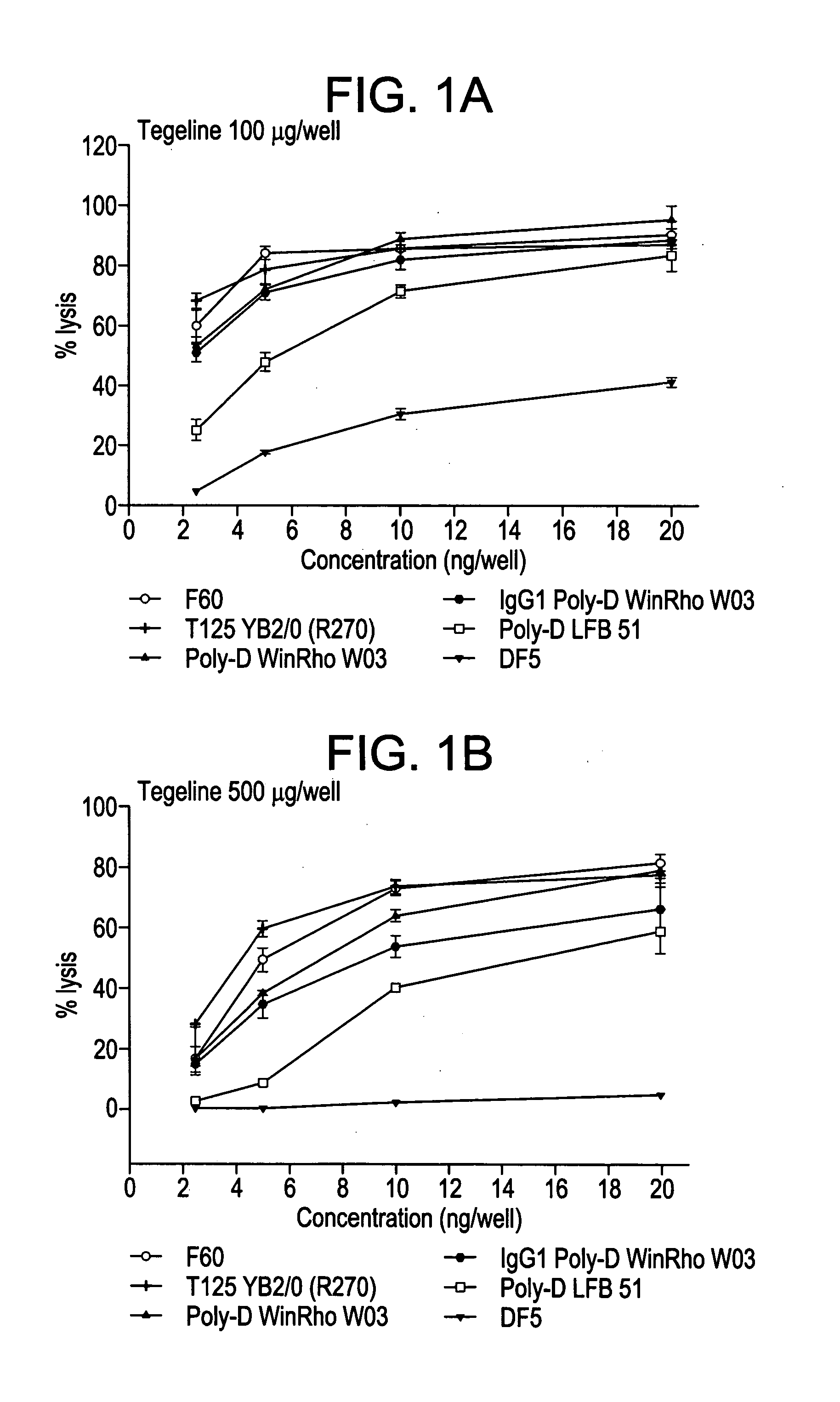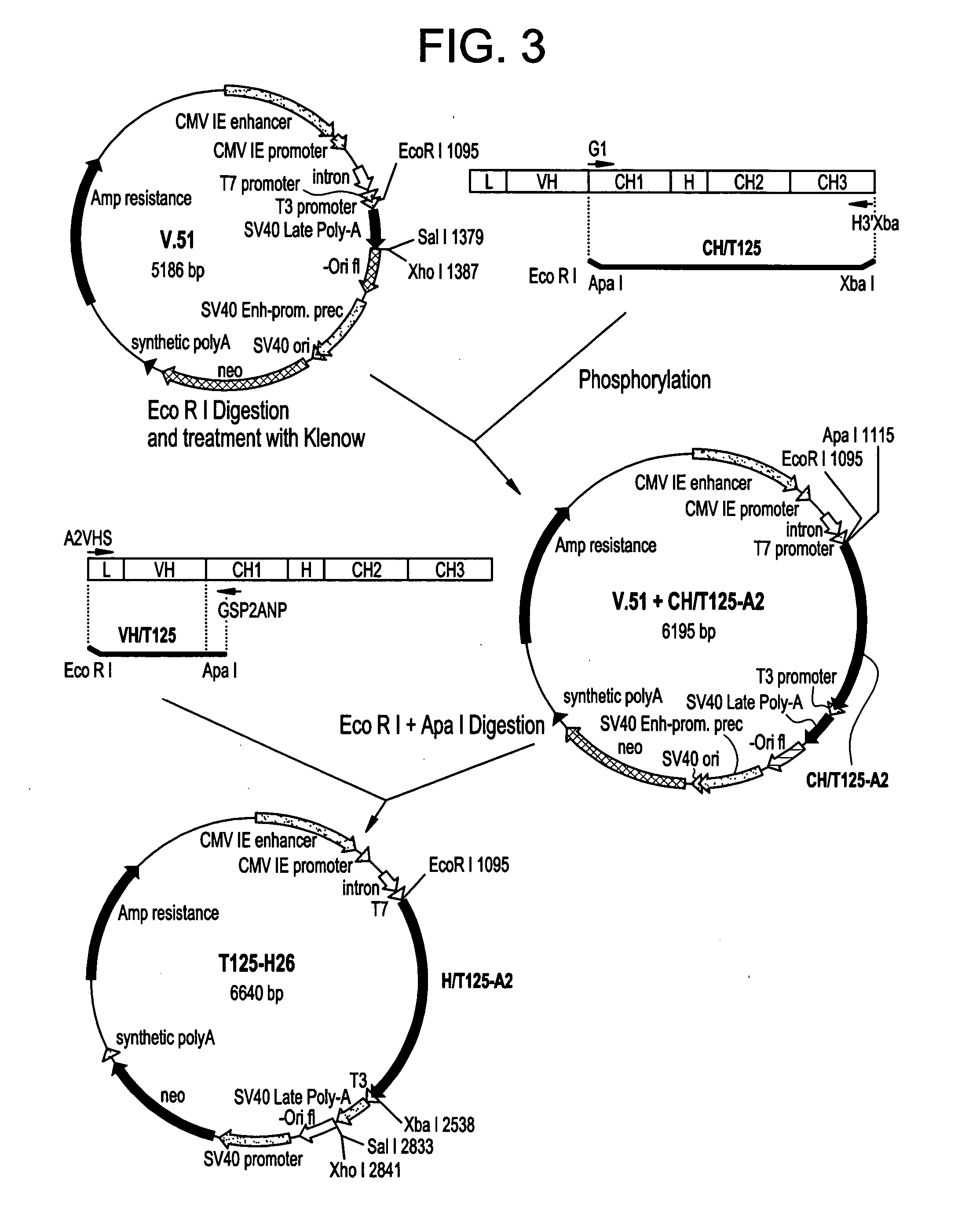Anti-Rhesus D monoclonal antibodies
a monoclonal antibody and antirhesus technology, applied in the field of antirhesus d monoclonal antibodies, can solve the problems of low immunization number of donors, polyclonal immunoglobulins, and inability to ensure the immunization of volunteers, so as to prevent alloimmunization
- Summary
- Abstract
- Description
- Claims
- Application Information
AI Technical Summary
Benefits of technology
Problems solved by technology
Method used
Image
Examples
example 1
Establishing a Heterohybrid Cell Line Producing an Anti-Rh(D) Antibody
1—Production of Lymphoblastoid and Heterohybrid Clones:
1.1—Lymphocyte Source:
[0079] The B lymphocyte donor is selected from anti-Rh(D) donors undergoing plasmapheresis, based on the activity of his or her anti-Rh(D) serum antibodies in the ADCC activity assay described in § 33. After a whole blood donation, in 1998, the “buffy coat” fraction (leukocyte concentrate) was recovered.
1.2-Immortalization of the B Lymphocytes From the Donor
[0080] The peripheral blood mononuclear cells are separated from the other elements by centrifugation on Ficoll Plus (Pharmacia). They are then diluted to 106 cell / ml in IMDM containing 20% (v / v) of fetal calf serum (FCS), to which 20% of culture supernatant of the B95-8 line (ATCC-CRL1612), 0.1 μg / ml of cyclosporin A (Sandoz), 50 μg / ml of gentamycin sulfate (Life Technologies) are added, and distributed into round-bottomed 96-well plates or 24-well plates (P24 Greiner). They a...
example 2
Production of a Recombinant Anti-D Antibody (Ab)
1—Isolation and Amplification of the cDNAs Encoding the Heavy and Light Chains of the Ab
1.1—RNA Extraction and cDNA Synthesis
[0118] The total RNAs were extracted from an anti-D Ab-producing clone (IgG G1 / Kappa) obtained by EBV transformation: T125 A2 (5 / 1) A2 (see paragraph 2, example 1).
[0119] The corresponding cDNAs were synthesized by reverse transcription of the total RNAs using oligo dT primers.
1.2—Amplification of the Variable Region of the Heavy Chain of T125-A2: VH / T125-A2 Sequence
[0120] The VH / T125-A2 sequence is obtained by amplification of the T125-A2 cDNAs using the following primers:
[0121] primer A2VH5, located 5′ of the leader region of the VH gene of T125-A2, introduces a consensus leader sequence (in bold) deduced from leader sequences already published and associated with VH genes belonging to the same VH3-30 family as the VH gene of T125-A2; this sequence also comprises an Eco RI restriction site (in italics...
example 3
Demonstration of the Relationship Between Glycan Structure and FcγRIII-Dependent activity
1—Cell Culture in the Presence of Deoxymannojirimycin (DMM)
[0152] Several studies describe the effect of enzymatic inhibitors on the glycosylation of immunoglobulins and on their biological activity. An increase in ADCC activity is reported by ROTHMAN et al., 1989, this being an increase which cannot be attributed to an enhancement of the affinity of the antibody for its target. The modification of glycosylation caused by adding DMM consists of inhibition of the α-1,2 mannosidase I present in le Golgi. It leads to the production of a greater proportion of polymannosylated, nonfucosylated structures.
[0153] Various anti-Rh(D) antibody-producing lines were brought into contact with DMM and the functional activity of the monoclonal antibodies produced was evaluated in the form of culture supernatants or after purification.
[0154] The cells (heterohybrid or lymphoblastoid cells) are seeded at bet...
PUM
| Property | Measurement | Unit |
|---|---|---|
| concentration | aaaaa | aaaaa |
| concentrations | aaaaa | aaaaa |
| concentrations | aaaaa | aaaaa |
Abstract
Description
Claims
Application Information
 Login to View More
Login to View More - R&D
- Intellectual Property
- Life Sciences
- Materials
- Tech Scout
- Unparalleled Data Quality
- Higher Quality Content
- 60% Fewer Hallucinations
Browse by: Latest US Patents, China's latest patents, Technical Efficacy Thesaurus, Application Domain, Technology Topic, Popular Technical Reports.
© 2025 PatSnap. All rights reserved.Legal|Privacy policy|Modern Slavery Act Transparency Statement|Sitemap|About US| Contact US: help@patsnap.com



